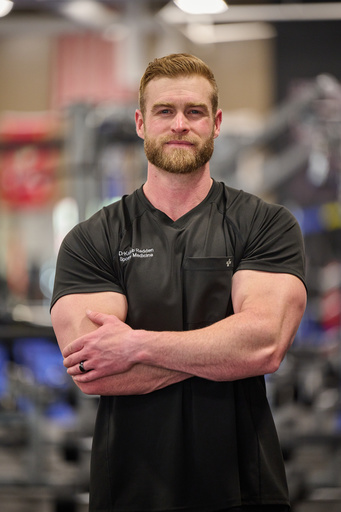


For Kaleb Redden, DO, sports medicine is not only his profession, it’s his personal passion. He’s often heard saying, “There is no substitute for strength and no excuse for the lack of it.” Kaleb competed in college athletics, where he learned firsthand about the impact of sports-related injuries—both to his back and to his ankles. Those experiences shifted his path from dreams of being a professional athlete, to caring for them instead. Today, he is a physician who specializes in sports medicine and orthopedic injuries.
A self-described adrenaline junkie, Kaleb is an avid outdoors enthusiast and competitive bodybuilder who made it to the finals of the NBC TV show The Titan Games in 2020. “It was an incredible experience to push myself physically and mentally,” he said.

After the grueling TV competition and many years of sports-related injuries, Kaleb’s ankle was unstable and vulnerable. He dislocated it during the competition, ramping up the pain he’d been living with for years. “I don’t remember a time in the last five years that my ankle didn’t hurt,” he said. But he kept going until he suffered a stress fracture on a solo outdoor adventure to Alaska. “That was one I couldn’t walk off. It scared me to realize how bad it was. And I was also developing significant arthritis from years of injuries.”
So, he turned to his practice partner, Kaitlin Neary, MD, an orthopedic surgeon and sports medicine specialist in Boise, Idaho, for help.
“When Kaleb came to see me, he had a significant amount of instability. He had tears to all three ligaments that stabilize the ankle,” she said. Further, Dr. Neary discovered Kaleb’s cartilage had taken serious hits with each injury, leaving him with significant damage to the bone at the bottom of his ankle joint, known as the talus. “He had chronic ankle sprains but always just walked it off,” she said. “He was so fit and so strong he could figure out ways to get around his ankle instability and how to cope functionally. But long-term that really catches up with you, if you do it long enough and compete at such a high level.”

Dr. Neary repaired Kaleb’s ankle by making small incisions and using DX Knotless FiberTak® anchors, the Syndesmosis TightRope® XP implant system and the InternalBrace™system. “The beauty of the InternalBrace system is that it helps protect the repair so you can accelerate the patient’s rehabilitation during the healing phase¹,²,” Dr. Neary said. “Studies have shown that using the InternalBrace system leaves the repaired ligament stronger than when a traditional Broström repair is performed.¹ The goal is still to get the ligaments to heal, but the InternalBrace system acts like a seatbelt, preventing the repair from stretching out and allows patients to get back on their feet faster.³ In the past I would have had to keep someone non-weightbearing for six weeks to give time for those ligaments to heal. Now, one-week post-op I get them into rehab. I get them walking five weeks sooner, which is remarkable.”
Dr. Neary also used a NanoNeedle Scope, which is a small, disposable camera, to perform minimally invasive arthroscopy to get a good look at Kaleb’s ankle joint and injuries. With that tool she was also able to remove the damaged cartilage. Finally, she applied BioCartilage®extracellular matrix to help it heal.

In Kaleb’s case, the addition of the BioCartilage matrix kept him non-weightbearing for six weeks. But it didn’t stop him from immediately jumping into rehab and getting back in the gym. “I feel great, my ankle is stable for the first time since I was 18 years old,” he said. “I don’t see any limitations following this surgery, I fully intend to be able to mountain bike as vigorously as I want to and get back to power lifting at full strength.”
Dr. Neary also expects him to make a full recovery. “We strive for perfection, that’s why we do this. Kaleb is a very motivated, active guy, so if anyone can get back to full activity, it’s him. He may be even better than he was before because he’s been doing so much with a really unstable ankle, up until now.”
With the advances in minimally invasive surgery, Kaleb says he now advises his own patients not to wait until chronic injuries turn into major problems. “A lot of people in my generation were told to rehab it and leave it alone. Now a lateral ankle reconstruction is so much quicker and more successful, and stability in your ankle makes a huge difference to your mobility and well-being,” he said. “You can return to your sport—it doesn’t matter what it is. It can just be the game of life, being a better spouse, a better parent, taking a walk with your family. You don’t need to be a professional athlete to enjoy the benefits of repairing a chronic injury and getting back to the things you love.”
References
Coetzee JC, Ellington JK, Ronan JA, Stone RM. Functional results of open Broström ankle ligament repair augmented with a suture tape.
Foot Ankle Int. 2018;39.107110071774236. doi:10.1177/1071100717742363
Viens NA, Wijdicks CA, Campbell KJ, Laprade RF, Clanton TO. Anterior talofibular ligament ruptures, part 1: biomechanical comparison of augmented Broström repair techniques with the intact anterior talofibular ligament.
Am J Sports Med. 2014;42(2):405-411. doi:10.1177/0363546513510141
Kulwin R, Watson TS, Rigby R, Coetzee JC, Vora A. Traditional modified Broström vs suture tape ligament augmentation.
Foot Ankle Int. 2021;1071100720976071. doi:10.1177/1071100720976071